Ground Glass Alignment Disks
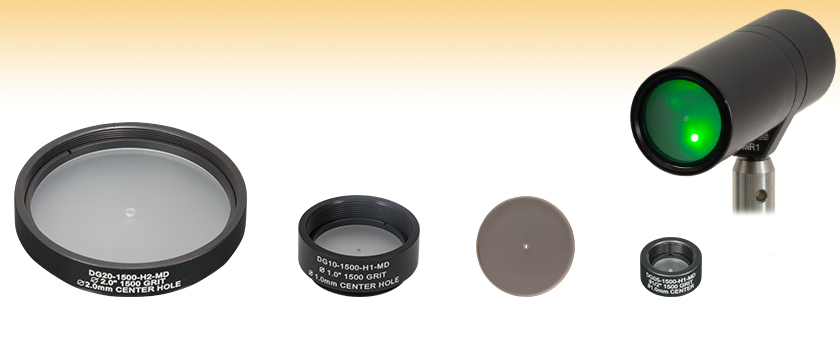
- Great for Viewing Beams Exiting a Lens Tube
- Ø1/2", Ø1", and Ø2" Versions Available
- Drilled Centering Hole
DG20-1500-H2-MD
DG10-1500-H1-MD
DG10-1500-H1
DG05-1500-H1-MD
Application Idea
A DG10-1500-H1 Unmounted Ø1" Frosted Glass Alignment Disk Is Used to Align a CPS520 Compact Laser Module

Please Wait
| Diffuser Selection Guide | |||
|---|---|---|---|
| Ground Glass Diffusers | |||
| Type | Material | Mounting, Coating | Operating Wavelength |
| Standard Diffusers | N-BK7 Substrate | Unmounted, Uncoated | 350 nm - 2.0 μm |
| Unmounted, AR Coated | 350 nm - 700 nm 650 nm - 1050 nm |
||
| Mounted, Uncoated | 350 nm - 2.0 µm | ||
| UVFS Substrate | Unmounted, Uncoated | 185 nm - 2.0 µm | |
| Diffuse Reflectors | N-BK7 Substrate | Unmounted, UV-Enhanced Aluminum Coated |
250 nm - 450 nm |
| Unmounted, Protected Silver Coated | 450 nm - 20 µm | ||
| Unmounted, Protected Gold Coated | 800 nm - 20 µm | ||
| Alignment Disks | |||
| Engineered Diffusers®* | |||
| Type | Material | Mounting, Coating | Operating Wavelength |
| Glass Diffusers | UVFS Substrate | Unmounted and Mounted, Uncoated | 400 nm - 700 nm |
| Polymer Diffusers | ZEONOR Substrate | Unmounted and Mounted, Uncoated | 400 nm - 700 nm |
| Diffuser Kits | |||
*Engineered Diffusers® is a registered trademark of VIAVI Solutions, Inc.
Features
- Made from 1500 Grit N-BK7 Ground Glass Substrate
- Center Hole Aids Alignment Process
- Ø1" Unmounted Alignment Disk
- Three Mounted Sizes Available:
- Ø1/2" Disk in an SM05-Threaded (0.535"-40) Mount
- Ø1" Disk in an SM1-Threaded (1.035"-40) Mount
- Ø2" Disk in an SM2-Threaded (2.035"-40) Mount
Our frosted glass alignment disks are made from 1500 grit Ground Glass Diffusers. Versions are available either unmounted or in an SM-threaded engraved cell. These disks are ideal for use when viewing a beam exiting a lens tube as the beam can be seen through the ground glass. An example of this is shown in the Application Idea pictured above. We also offer other alignment tools as well as fluorescent viewing cards.
Insights into Aligning a Laser Beam
When installing a laser in an optical setup, it is good practice to start by leveling and orienting its beam so that it travels along a well-defined path. When the beam is prepared this way, not only is it easier to then divert the beam and route it through the optical elements in the system, but the results provided by tuning the system's alignment are more predictable and repeatable. The following sections describe how to:
- Level and Align the Laser Beam's Pointing Angle
- Divert the Beam and Align it to Follow a Desired Path
Click here for more Insights about lab practices and equipment.
Level and Align the Laser Beam's Pointing Angle
0:00 - Introduction
1:25 - Level and Align the Laser Beam's Pointing Angle
4:09 - Divert the Beam and Align it to Follow a Desired Path
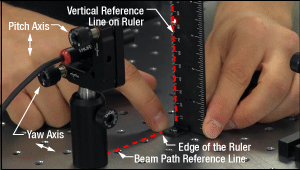
Click to Enlarge
Figure 196C The beam can be aligned to travel parallel to a line of tapped holes in the optical table. The yaw adjustment on the kinematic mount adjusts the beam angle, so that the beam remains incident on the ruler's vertical reference line as the ruler slides along the line of tapped holes.
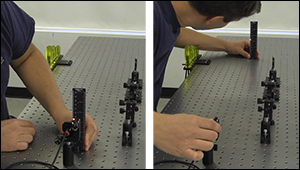
Click to Enlarge
Figure 196B Leveling the beam path with respect to the surface of an optical table requires using the pitch adjustment on the kinematic laser mount (Figure 196C). The beam is parallel to the table's surface when measurements of the beam height near to (left) and far from (right) the laser's front face are equal.
Pitch (tip) and yaw (tilt) adjustments provided by a kinematic mount can be used to make fine corrections to a laser beam's angular orientation or pointing angle. This angular tuning capability is convenient when aligning a collimated laser beam to be level with respect to a reference plane, such as the surface of an optical table, and when aligning with respect to a particular direction in that plane, such as along a line of tapped holes in the table.
Before Using the Mount's Adjusters
First, rotate each adjuster on the kinematic mount to the middle of its travel range. This reduces the risk of running out of adjustment range, and the positioning stability is frequently better when at the center of an adjuster's travel range.
Then, make coarse corrections to the laser's height, position, and orientation. This can be done by adjusting the optomechanical components, such as a post and post holder, supporting the laser. Ensure all locking screws are tightened after the adjustments are complete.
Level the Beam Parallel to the Table's Surface
Leveling the laser beam is an iterative process that requires an alignment tool and the fine control provided by the mount's pitch adjuster.
Begin each iteration by measuring the height of the beam close to and far from the laser (Figure 196B). A larger distance between the two measurements increases accuracy. If the beam height at the two locations differs, place the ruler in the more distant position. Adjust the pitch on the kinematic mount until the beam height at that location matches the height measured close to the laser. Iterate until the beam height at both positions is the same.
More than one iteration is necessary, because adjusting the pitch of the laser mount adjusts the height of the laser emitter. In Video 196A, for example, the beam height close to the laser was initially 82 mm, but it increased to 83 mm after the pitch was adjusted during the first iteration.
If the leveled beam is at an inconvenient height, the optomechanical components supporting the laser can be adjusted to change its height. Alternatively, two steering mirrors can be placed after the laser and aligned using a different procedure, which is detailed in the section. Steering mirrors are particularly useful for adjusting beam height and orientation of a fixed laser.
Orient the Beam Along a Row of Tapped Holes
Aligning the beam parallel to a row of tapped holes in the table is another iterative process, which requires an alignment tool and tuning of the mount's yaw adjuster.
The alignment tool is needed to translate the reference line provided by the tapped holes into the plane of the laser beam. The ruler can serve as this tool, when an edge on the ruler's base is aligned with the edges of the tapped holes that define the line (Figure 196C).
The relative position of the beam with respect to the reference line on the table can be evaluated by judging the distance between the laser spot and vertical reference feature on the ruler. Vertical features on this ruler include its edges, as well as the columns formed by different-length rulings. If these features are not sufficient and rulings are required, a horizontally oriented ruler can be attached using a BHMA1 mounting bracket.
In Video 196A, when the ruler was aligned to the tapped holes and positioned close to the laser, the beam's edge and the ends of the 1 mm rulings coincided. When the ruler was moved to a farther point on the reference line, the beam's position on the ruler was horizontally shifted. With the ruler at that distant position, the yaw adjustment on the mount was tuned until the beam's edge again coincided with the 1 mm rulings. The ruler was then moved closer to the laser to observe the effect of adjusting the mount on the beam's position. This was iterated as necessary.
Divert the Beam and Align it to Follow a Desired Path
The first steering mirror reflects the beam along a line that crosses the new beam path. A second steering mirror is needed to level the beam and align it along the new path. The procedure of aligning a laser beam with two steering mirrors is sometimes described as walking the beam, and the result can be referred to as a folded beam path. In the example shown in Video 196A, two irises are used to align the beam to the new path, which is parallel to the surface of the optical table and follows a row of tapped holes.
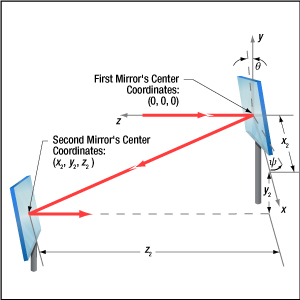
Click to Enlarge
Figure 196D The beam reflected from Mirror 1 will be incident on Mirror 2, if Mirror 1 is rotated around the x- and y-axes by angles θ and ψ, respectively. Both angles affect each coordinate (x2 , y2 , z2 ) of Mirror 2's center. Mirror 1's rotation around the x-axis is limited by the travel range of the mount's pitch (tip) adjuster, which limits Mirror 2's position and height options.
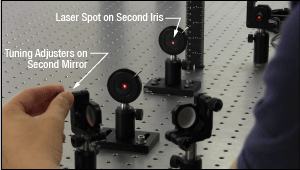
Click to Enlarge
Figure 196F The adjusters on the second kinematic mirror are used to align the beam on the second iris.
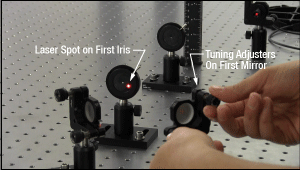
Click to Enlarge
Figure 196E The adjusters on the first kinematic mirror mount are tuned to position the laser spot on the aperture of the first iris.
Setting the Heights of the Mirrors
The center of the first mirror should match the height of the input beam path, since the first mirror diverts the beam from this path and relays it to a point on the second mirror. The center of the second mirror should be set at the height of the new beam path.
Iris Setup
The new beam path is defined by the irises, which in Video 196A have matching heights to ensure the path is level with respect to the surface of the table. A ruler or calipers can be used to set the height of the irises in their mounts with modest precision.
When an iris is closed, its aperture may not be perfectly centered. Because of this, switching the side of the iris that faces the beam can cause the position of the aperture to shift. It is good practice to choose one side of the iris to face the beam and then maintain that orientation during setup and use.
Component Placement and Coarse Alignment
Start by rotating the adjusters on both mirrors to the middle of their travel ranges. Place the first mirror in the input beam path, and determine a position for the second mirror in the new beam path (Figure 196D). The options are notably restricted by the travel range of the first mirror mount's pitch (tip) actuator, since it limits the mirror's rotation (θ ) around its x-axis. In addition to the pitch, the yaw (tilt) of the first mirror must also be considered when choosing a position
After placing the second mirror on the new beam path, position both irises after the second mirror on the desired beam path. Locate the first iris near the second mirror and the second iris as far away as possible.
While maintaining the two mirrors' heights and without touching the yaw adjusters, rotate the first mirror to direct the beam towards the second mirror. Adjust the pitch adjuster on the first mirror to place the laser spot near the center of the second mirror. Then, rotate the second mirror to direct the beam roughly along the new beam path.
First Hit a Point on the Path, then Orient
The first mirror is used to steer the beam to the point on the second mirror that is in line with the new beam path. To do this, tune the first mirror's adjusters while watching the position of the laser spot on the first iris (Figure 196E). The first step is complete when the laser spot is centered on the iris' aperture.
The second mirror is used to steer the beam into alignment with the new beam path. Tune the adjusters on the second mirror to move the laser spot over the second iris' aperture (Figure 196F). The pitch adjuster levels the beam, and the yaw adjuster shifts it laterally. If the laser spot disappears from the second iris, it is because the laser spot on the second mirror has moved away from the new beam path.
Tune the first mirror's adjusters to reposition the beam on the second mirror so that the laser spot is centered on the first iris' aperture. Resume tuning the adjusters on the second mirror to direct the laser spot over the aperture on the second iris. Iterate until the laser beam passes directly through the center of both irises, as shown in Video 196A. If any adjuster reaches, or approaches, a limit of its travel range, one or both mirrors should be repositioned and the alignment process repeated.
If a yaw axis adjuster has approached a limit, note the required direction of the reflected beam and then rotate the yaw adjuster to the center of its travel range. Turn the mirror in its mount until the direction of the reflected beam is approximately correct. If the mirror cannot be rotated, reposition one or both mirrors to direct the beam roughly along the desired path. Repeat the alignment procedure to finely tune the beam's orientation.
If a pitch axis adjuster has approached a limit, either increase the two mirrors' separation or reduce the height difference between the new and incident beam paths. Both options will result in the pitch adjuster being positioned closer to the center of its travel range after the alignment procedure is repeated.
| Posted Comments: | |
Martina Gebbe
(posted 2020-11-10 06:21:46.53) I could not find any information about a damage threshold of these alignment disks. I would like to align a 780nm beam with a power of up to 3W which is probably too much for these disks. YLohia
(posted 2020-11-11 10:09:41.0) Hello, thank you for contacting Thorlabs. The damage threshold of uncoated optics is strongly influenced by the surface finish, which is especially relevant to diffusers, as well as subsurface damage. Laser damage is a concern with optics because it prevents them from performing their function, which for this part is simply visual alignment and that should not be significantly impacted by laser damage. While we have not performed damage threshold testing on these disks so we cannot guarantee a particular outcome, we would not expect your 780 nm 3 W beam to cause damage. toewj
(posted 2016-04-08 00:29:18.483) Will this alignment guide work for 266 nm lasers? besembeson
(posted 2016-04-11 11:28:11.0) Response from Bweh at Thorlabs USA: No it will not. The DG10-1500-H1-MD is made with N-BK7 substrate and designed for visible spectrum, and not deep UV which will not be visible on the glass. rsink
(posted 2014-09-24 09:35:28.547) The drawing for this part says it is ground on BOTH sides. Is this correct? How can you project visible image on it if both sides are ground?
Thanks,
Rick Sink jlow
(posted 2014-09-25 09:25:53.0) Response from Jeremy at Thorlabs: The part is grounded on both sides. I will contact you directly to discuss about using this in your application. bdada
(posted 2011-10-21 12:25:00.0) Response from Buki at Thorlabs:
Thank you for your feedback. The DG20-1500-H2 is currently showing on our website. Please contact TechSupport@thorlabs.com if you have further questions about this product. user
(posted 2011-10-20 16:00:12.0) DG20-1500-H2 Frosted Glass Alignment Disk, Ø2",
Ø2 mm Hole .... item disappeared? |

- 1500 Grit Ground Glass on Both Sides
- Drilled Centering Hole
- Great for Viewing Beams Exiting a Lens Tube
This frosted glass alignment disk is made from a 1500 grit Ground Glass Diffuser. The DG10-1500-H1 is Ø1" (Ø25.4 mm), and features a Ø1 mm (Ø0.04") hole drilled in the center for alignment purposes. The disk is ideal for use when viewing a beam exiting a lens tube as the beam can be seen through the ground glass. An example of this is shown in the Application Idea pictured above. The disk is also available mounted in SM threaded cells in the section below.

- SM05, SM1, or SM2 Threaded Versions
- 1500 Grit Ground Glass on Both Sides with Drilled Centering Hole
- Great for Viewing Beams Exiting a Lens Tube
- Mounting Cells Include Engraved Part Number, Grit, and Center Hole Diameter
Our frosted glass alignment disks are also available mounted in SM threaded cells. The 1500 grit N-BK7 diffusers are excellent alignment targets for visible beams. An incident beam can be easily seen on either side of the disk and aligned to the Ø1 mm centering hole on the Ø1/2" and Ø1" versions or the Ø2 mm hole on the Ø2" version. The SM threaded mounts allow the alignment disks to be quickly inserted or removed from an optical system without the need of retaining rings and spanner wrenches to secure the disk within a system. Please see the section immediately above for unmounted frosted alignment disks.
 Products Home
Products Home











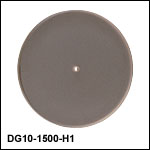
 Zoom
Zoom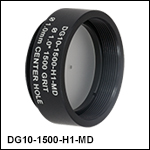
 Ground Glass Alignment Disks
Ground Glass Alignment Disks